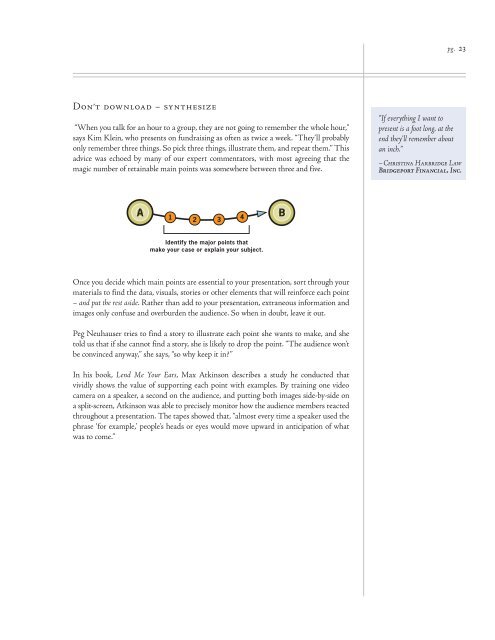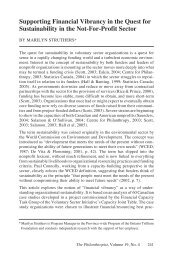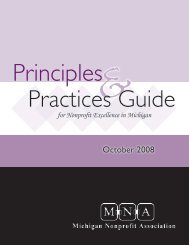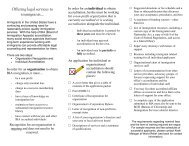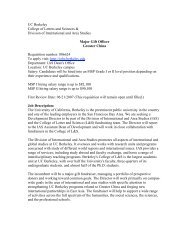Why Bad Presentations Happen to Good Causes - The Goodman ...
Why Bad Presentations Happen to Good Causes - The Goodman ...
Why Bad Presentations Happen to Good Causes - The Goodman ...
You also want an ePaper? Increase the reach of your titles
YUMPU automatically turns print PDFs into web optimized ePapers that Google loves.
Don’t download – synthesize<br />
“When you talk for an hour <strong>to</strong> a group, they are not going <strong>to</strong> remember the whole hour,”<br />
says Kim Klein, who presents on fundraising as often as twice a week. “<strong>The</strong>y’ll probably<br />
only remember three things. So pick three things, illustrate them, and repeat them.” This<br />
advice was echoed by many of our expert commenta<strong>to</strong>rs, with most agreeing that the<br />
magic number of retainable main points was somewhere between three and five.<br />
A B<br />
1 2 3<br />
4<br />
Identify the major points that<br />
make your case or explain your subject.<br />
Once you decide which main points are essential <strong>to</strong> your presentation, sort through your<br />
materials <strong>to</strong> find the data, visuals, s<strong>to</strong>ries or other elements that will reinforce each point<br />
– and put the rest aside. Rather than add <strong>to</strong> your presentation, extraneous information and<br />
images only confuse and overburden the audience. So when in doubt, leave it out.<br />
Peg Neuhauser tries <strong>to</strong> find a s<strong>to</strong>ry <strong>to</strong> illustrate each point she wants <strong>to</strong> make, and she<br />
<strong>to</strong>ld us that if she cannot find a s<strong>to</strong>ry, she is likely <strong>to</strong> drop the point. “<strong>The</strong> audience won’t<br />
be convinced anyway,” she says, “so why keep it in?”<br />
In his book, Lend Me Your Ears, Max Atkinson describes a study he conducted that<br />
vividly shows the value of supporting each point with examples. By training one video<br />
camera on a speaker, a second on the audience, and putting both images side-by-side on<br />
a split-screen, Atkinson was able <strong>to</strong> precisely moni<strong>to</strong>r how the audience members reacted<br />
throughout a presentation. <strong>The</strong> tapes showed that, “almost every time a speaker used the<br />
phrase ‘for example,’ people’s heads or eyes would move upward in anticipation of what<br />
was <strong>to</strong> come.”<br />
pg. 23<br />
“If everything I want <strong>to</strong><br />
present is a foot long, at the<br />
end they’ll remember about<br />
an inch.”<br />
– Christina Harbridge Law<br />
Bridgeport Financial, Inc.


